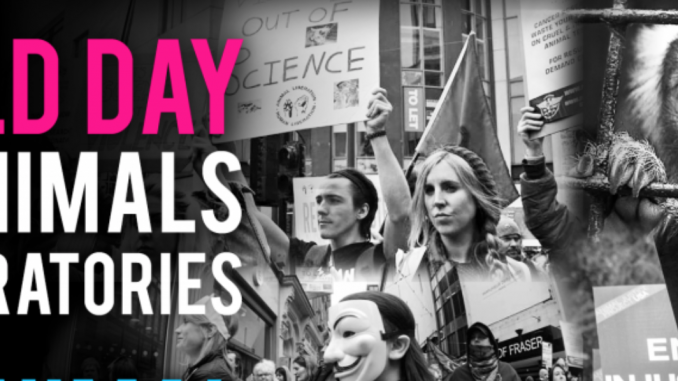
Yesterday saw part one of the World Day at 40 boxset which highlighted some of the amazing campaigns, actions and people who fought against vivisection in the eighties and nineties. Part two joins the struggle during a momentous period as the Hillgrove Campaign is beginning. Meanwhile an animal rights activist was showing how to fight back even when in prison. Each of these entries orginally appeared separately over 40 days on the World Day for Animals in Laboratories Facebook page in the runup to this year’s protest in Oxford. Now they are collected here in “boxset” form.

World Day at 40: 1997-98. Barry Horne was an animal rights prisoner who went on hunger strike three times to highlight the suffering of laboratory animals and the lies of politicians.
The first hunger strike, in Jan 1997, demanded the withdrawal of state funding of animal testing within five years. There was a huge upsurge in activism, especially against vivisection, with animals rescued from lab animal breeders Consort and Hillgrove.
Barry began eating after 35 days when the Labour Party hinted it would act against vivisection if it won the general election in May.
The second hunger strike began in August 1997 after Labour failed to keep its promises. It again saw a massive outpouring of action against labs and breeders. The vivisection industry as a whole had never come under such pressure before. Barry ended his hunger strike after 46 days when the Home Office agreed to meet his supporters.
Barry needed a long time to recover but in October 1998 he again refused food when it became clear Labour had lied. More meetings between his supporters and the Home Office came to nothing and after 49 days Barry was rushed to hospital. The world’s media took notice and camped outside.
As protests and direct action grew, the government and vivisection industry feared the backlash if Barry died. It was even discussed by the Animal Procedures Committee which regulated animal experiments.
On day 64 and near death Barry was suddenly transfered back to prison and away from his support group. He was no longer able to focus and sometimes forgot he was on hunger strike. On day 68 he decided to eat again and was rushed back to hospital.
Barry never fully recovered and died in November 2001 from liver failure. His courage and determination inspired activists throughout the world.
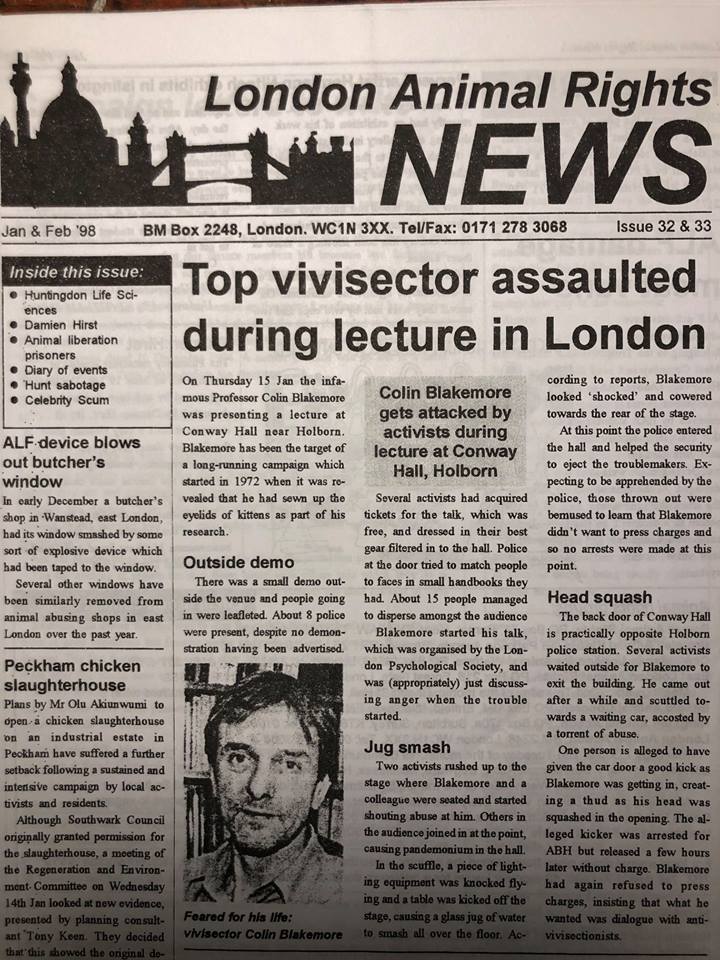
World Day at 40: 1998. Oxford University professor assaulted at lecture in London. Colin Blakemore was the most infamous vivisector in Britain, reviled for sewing up the eyes of animals.
Activists found out he was speaking and acquired tickets for his talk. Two rushed up to where he was seated and shouted abuse at him. Others joined in “causing pandemonium in the hall”. A scuffle ensued and objects were knocked over, including a jug of water which shattered on the floor.
Blakemore was “shocked” and “cowered towards the rear of the stage.” Police entered and helped eject the troublemakers but the vivisector’s ordeal was far from over. As he exited to a “torrent of abuse”, one activist gave his car door a good kick and allegedly ‘his head was squashed in the opening” as he was getting in.
The activist was arrested for ABH yet released a few hours later. Blakemore did not want to press charges, “insisting that what he wanted was dialogue with anti-vivisectionists”.
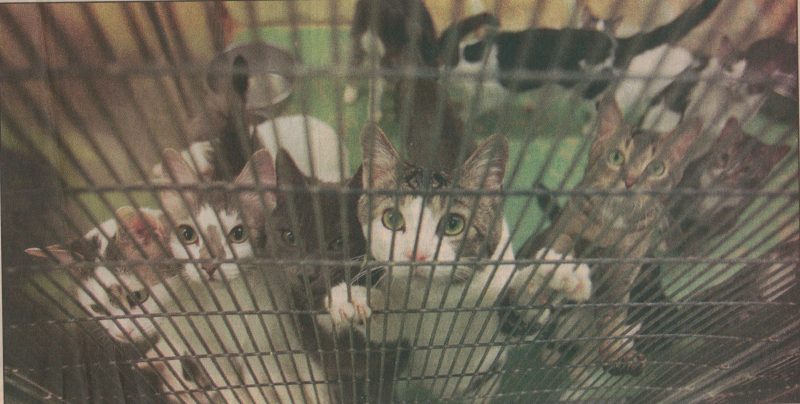
World Day at 40: 1999. Hillgrove Farm in Witney, Oxfordshire, closed after a bitterly fought struggle. Owned by Christopher Brown for 30 years, it bred cats for laboratories in the UK and abroad and was very profitable.
In August 1997 Greg Avery and Heather Nicholson set up Save the Hillgrove Cats, hot on the heels of closing Consort Beagles, and Hillgrove quickly became a focal point for campaigners.
Protests took place almost every day, all night vigils kept Brown awake and his workers received regular “home visits”. The Camping Club, Caravan Club and Ramblers Association all withdrew support for Brown’s B’n’B and campsite due to a “massive letter writing campaign”.
1500 activists turned up on World Day 1998 to find an enormous fence erected around the cattery. There followed something akin to a medieval siege as people tried to tear it down, while others smashed the windows and roof of Brown’s cottage with stones.
Thames Valley Police fought back with a five mile exclusion zone but protesters went to Oxford instead, causing mayhem in the city centre and at the University, which used cats from Hillgrove. The exclusion zone was revoked and protests returned to Witney.
Brown was telephoned thousands of times, received black faxes, tons of junk mail, hate mail and unwanted items like plates and books. Night visits saw his telephone pole chopped down and property damaged.
When his wife was allegedly attacked he could take no more and Hillgrove closed on 12 August. 800 cats were rehomed by the RSPCA and the Mirror newspaper said: “The campaigners who fought so hard deserve their moment of triumph. It is a victory for humanity”.
Hillgrove was unlike anything animal rights had seen before. Over 350 people were arrested, 21 imprisoned and policing costs totalled £2.8m. It remains a landmark in antivivisection history.
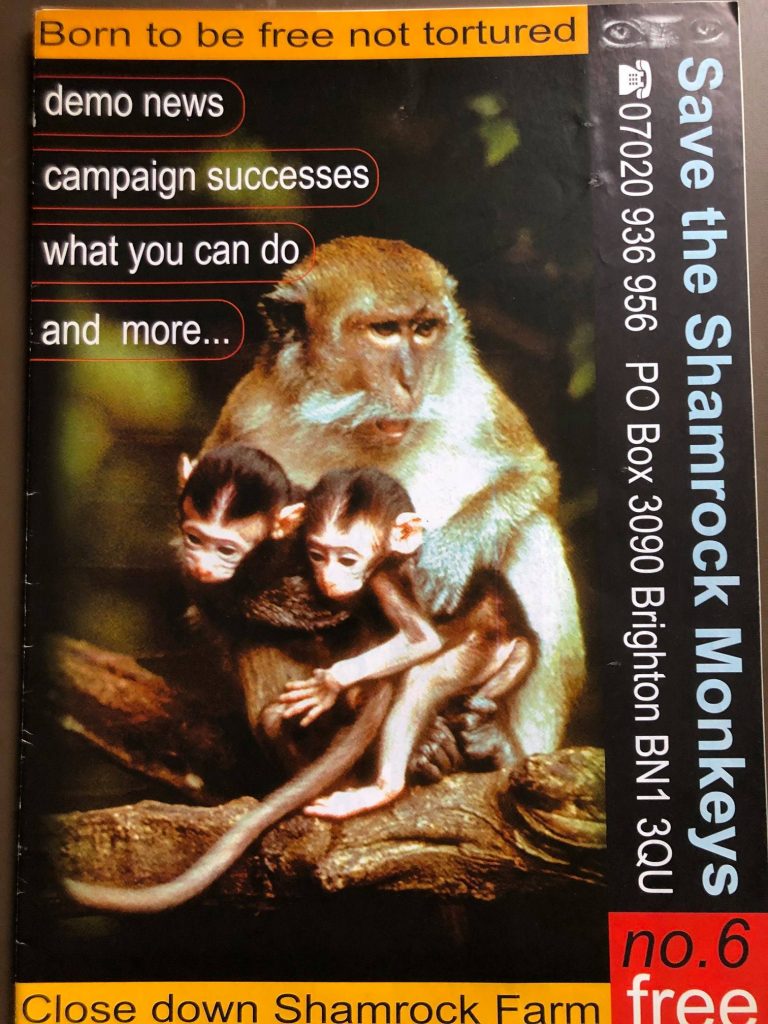
World Day at 40: 2000. On 9 March Shamrock Farm, importer of primates from Asia, announced it would be closing permanently. Save the Shamrock Monkeys (SSM) was formed in 1998 to drive the facility out of business by using a model of campaigning that worked on other laboratory suppliers.
Its target was 45 years old, had an annual turnover of £3m and 17 staff yet it lasted less than 16 months. A mix of demos such as “greeting” workers, all night vigils and large national actions which drew up to 1000 people – local residents and activists from across the country – wore it down, though the final straw was an arson attack on a director’s car.
Shamrock claimed all its primates would be “humanely relocated” but they sold every single monkey into the hands of vivisectors. SSM said: “As much as we would like to make their lives hell, we have better things to do and another campaign to launch.”
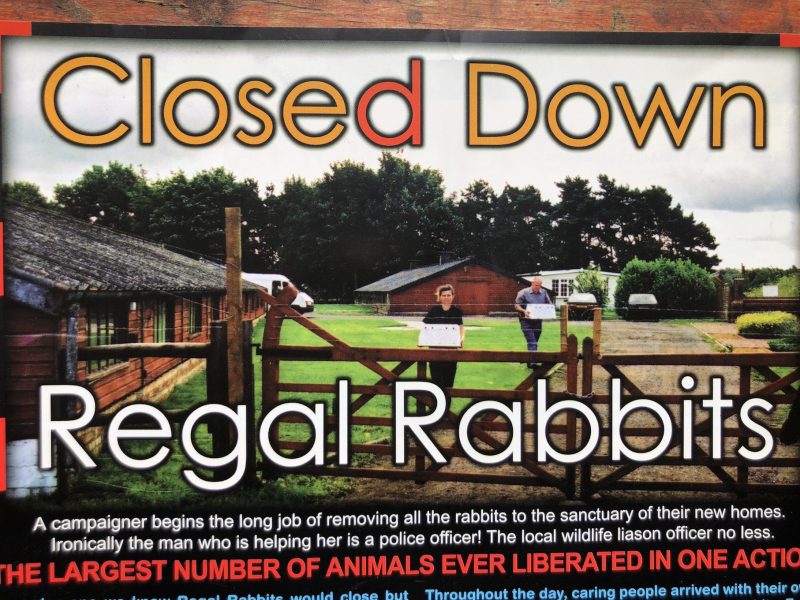
World Day at 40: 2000. In May the ALF raided Regal Rabbits, saving 70 rabbits from torture and death. The same activists who had finished off Shamrock Farm then formed Close Down Regal Rabbits to put the lab animal breeder out of business within one year.
On 25 June 20 masked protesters entered the premises to gather evidence of cruelty and take photos. The owner Bill Pitcher came out moaning: “Oh no! Not again!” The next day Pitcher’s phone began ringing as his contact details were shared.
At a vigil on 2 July, Pitcher and his partner were treated to Bright Eyes played non-stop on a megaphone. When the local animal rights group arrived, Pitcher suggested “selling the rabbits for meat might be acceptable to all parties.”
After Pitcher and three members of staff attacked protesters, 50 masked activists smashed the windows of his house and attempted to break down the door. They escaped before police arrived.
The next day, 8 July, Pitcher announced Regal Rabbits was closing. When asked if he would hand over the rabbits, he replied, “do I have a choice?” That meant 1153 animals needed rehoming.
On Monday 10th a “military-style operation” with dozens of vehicles took the rescued rabbits to their new homes. From start to finish the campaign had lasted two weeks.
CDRR said: “It was short but as sweet a victory as it could possibly be. And it’s been made all the sweeter by knowing we are such a force to be reckoned with that the vivisectors and their suppliers would rather hand over their whole business than face a national campaign by the whole AR movement.”
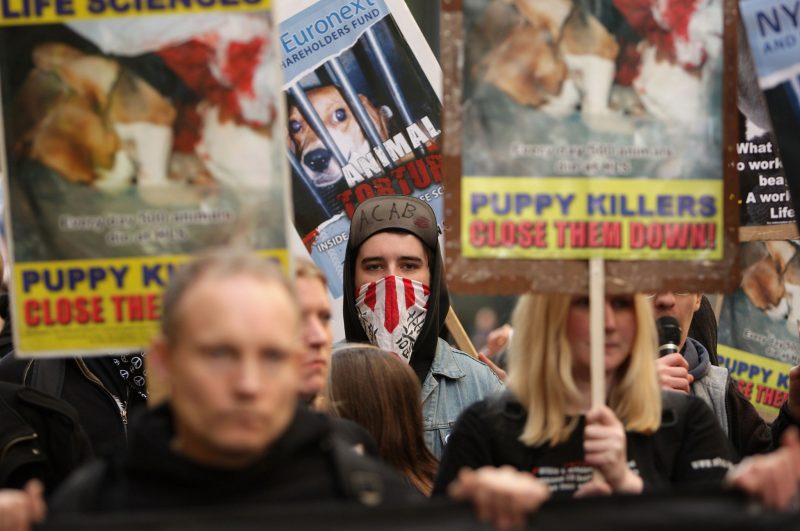
World Day at 40: 2001. Huntingdon Life Sciences given last minute reprieve. HLS, Europe’s largest contract testing laboratory, nearly went bankrupt in January when it was unable to pay off its debts.
The company had been targeted by anti-vivisectionists, especially the group Stop Huntingdon Animal Cruelty, following a secret investigation in 1997 which showed horrific animal cruelty.
Only the last minute intervention of Lord Sainsbury, New Labour science minister, allowed a deal to be brokered and eventually Royal Bank of Scotland wiped off the £11m owed to it for just £1. Meanwhile another financial institution, whose identity was kept secret, handed HLS a lifeline by extending the remaining loan.
SHAC was defiant, saying it would “destroy” anyone who funded the company. Despite state repression and mass arrests the campaign went on for a further 13 years until SHAC announced it was folding.
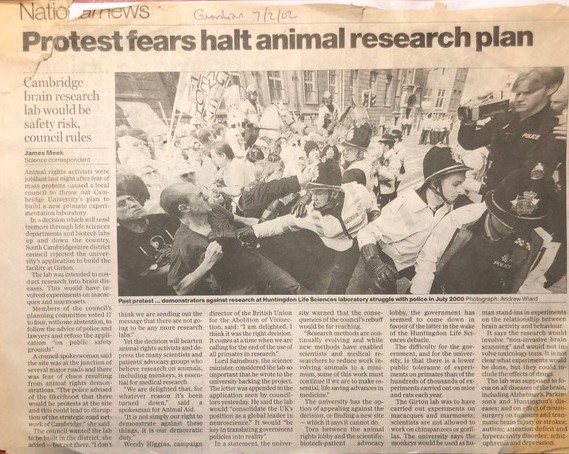
World Day at 40: 2004. Laboratory plan scrapped. Stop Primate Experiments At Cambridge was formed in 2003 to oppose “a massive centre to carry out experiments on monkeys”. The lab won £24m backing from the Labour government that had promised to reduce vivisection. SPEAC organised regular protests at the proposed site and at the university itself.
The local council had rejected the application in 2002 due to fear of “traffic chaos and disturbance to locals” from animal rights protests. However the university lodged an appeal and Deputy PM John Prescott gave it the go ahead. Tony Blair and science minister Lord Sainsbury also backed the project.
But the university was already under pressure following an undercover investigation by the BUAV which found shocking cruelty towards marmosets. In January 2004 Animal Aid and the NAVS lodged an appeal against Prescott’s “perverse and unreasonable” decision.
Later that month, however, the plan was abandoned owing to financial difficulties. The university said costs had risen by £8m, no doubt some of that due to spiralling security. Antivivisectionists claimed victory and cited the impact of the nearby campaign against Huntingdon Life Sciences, which must have alarmed those behind the lab.

World Day at 40: 2004. Construction of an £18m biosciences laboratory at Oxford University was halted in July. The company behind the lab, Montpellier, withdrew due to protests and direct action.
Following its victory in stopping the Cambridge lab, SPEAC became Speak and focused on Oxford. An early success saw Travis Perkins, one of the largest suppliers of building materials, stopping delivering to the site.
Shareholders of Montpellier then received letters from the ALF telling them to sell their shares or face their details being published on the web. Shares plummeted by 19% in one day.
Next it was the turn of concrete supplier, RMC. Eleven lorries were destroyed and “every piece of equipment totally smashed” in the first action. Channel 4 News had a map with locations and it soon filled up with attacks. The final one saw “three huge vehicles destroyed by fire, as well as the site offices and other buildings”.
When building work came to a halt, it caused uproar in the ruling elite. New Labour had been propping up Huntingdon Life Sciences for years due to the SHAC campaign, now it had a second front to fight – the most famous university in the world.
As costs soared Oxford graduate Tony Blair visited and reassured those in charge they had government backing to the tune of £100m. The media called for new laws against “animal rights extremists” that would “send a message to universities and companies across the world who might otherwise be reluctant to invest in research in the UK that relies on animal testing”.
Work did not resume until November 2005. Site staff wore balaclavas to conceal their identities and the name of the building company was not revealed. By this time an injunction was in place to restrict protests against the university.
The lab finally opened in 2008, three years behind schedule. Speak still campaigns in Oxford and says it will “continue to represent the voices of progressive scientific opinion and public concern about animal suffering in research labs”.
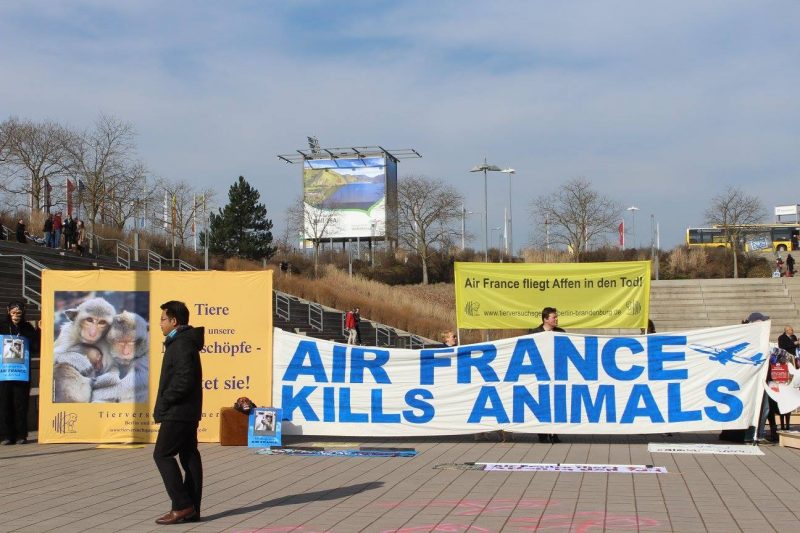
World Day at 40: 2005. Gateway to Hell was a campaign targeting airlines who carried laboratory animals, especially monkeys. As well as facing cruel experiments, they also had to endure horrific conditions in transit. For example 25 long-tailed macaques died while being shipped from Cambodia to the US in 2016.
Animal rights groups campaigned under the Gateway to Hell banner in at least 15 countries across Europe, in the US and other parts of the world where animals were bred or caught before being shipped abroad.
An early victory was claimed in 2005 when British Airways banned animals destined for labs. Another breakthrough came four years later when the Nepalese government stopped breeding monkeys and released those held in farms back into the wild.
The number of airlines carrying lab animals was whittled down until just Air France/KLM/Martinair remained. Over several years there were regular protests at airports and pickets of the company’s offices and director’s homes. However by early 2017, for reasons that are unclear, the campaign wound down.
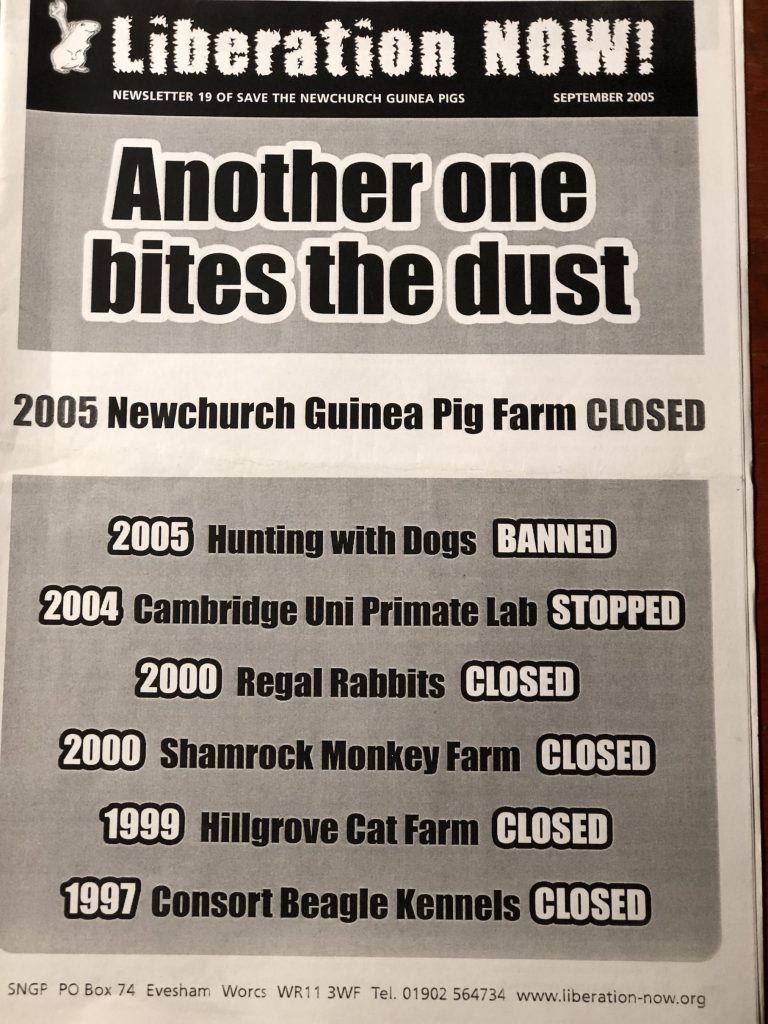
World Day at 40: 2005. Newchurch guinea pig farm announced its closure after a six year campaign by Save the Newchurch Guinea Pigs.
SNGP was founded following an ALF raid in 1999 that rescued 600 guinea pigs destined for laboratories. Photos and videos showed dirty, barren, crowded conditions inside the breeding sheds, as well as unhealthy and dying guinea pigs.
The group’s newsletter Liberation Now! said: “We are telling the Halls to close down now. This campaign is going to run until they do.” Daily demos and night vigils began immediately and within days Amtrak, the parcel delivery company, severed ties with the business.
By 2004 years of obscene and threatening phone calls, letters and emails, fireworks set off outside their homes in the night and graffiti sprayed on their property, as well as being ostracised from their own community – including their golf club – had the Halls on the brink.
In October 2004 the remains of Christopher Hall’s mother-in-law, Gladys Hammond, were taken from her grave. SNGP said it had nothing to do with the desecration. In May 2006 the remains were recovered and the following week four activists were convicted of conspiracy to blackmail, receiving sentences of up to 12 years each.
A victory march was held shortly after Newchurch’s closure in July 2005 and it was widely assumed it would be only a matter of time before the next breeder or lab succumbed. However, draconian new laws and mounting state repression mean it is, to date, the last.
Nonetheless it was an incredible achievement. As the final edition of Liberation Now! put it: “This is a great victory for everyone who is against animal abuse, it is fantastic news!”

World Day at 40: 2006. Greg Avery was interviewed by the Guardian seven years after he co-founded Stop Huntingdon Animal Cruelty with the aim of closing Europe’s biggest contract testing laboratory, Huntingdon Life sciences. It had managed to survive but only in a perilous state and with state assistance.
“Love them or loathe them,” the article says, “the core of 10 individuals at the heart of SHAC have for ever changed the way tiny, single-interest pressure groups will wage war against big business”
Avery is quoted as saying: “Whatever you think of us, whether you like us and think we’re the equivalent of Mary Poppins, or whether you regard us as mad extremists, you have to admit one thing – what we do works”.
Greg and other leading figures in SHAC were arrested in 2007 for conspiracy to blackmail. Greg and his wife Natasha accepted their guilt and received nine years. Heather Nicholson pleaded not guilty and was sentenced to 11 years in prison. All three were given lifetime ASBOs forbidding them to campaign against vivisection ever again.
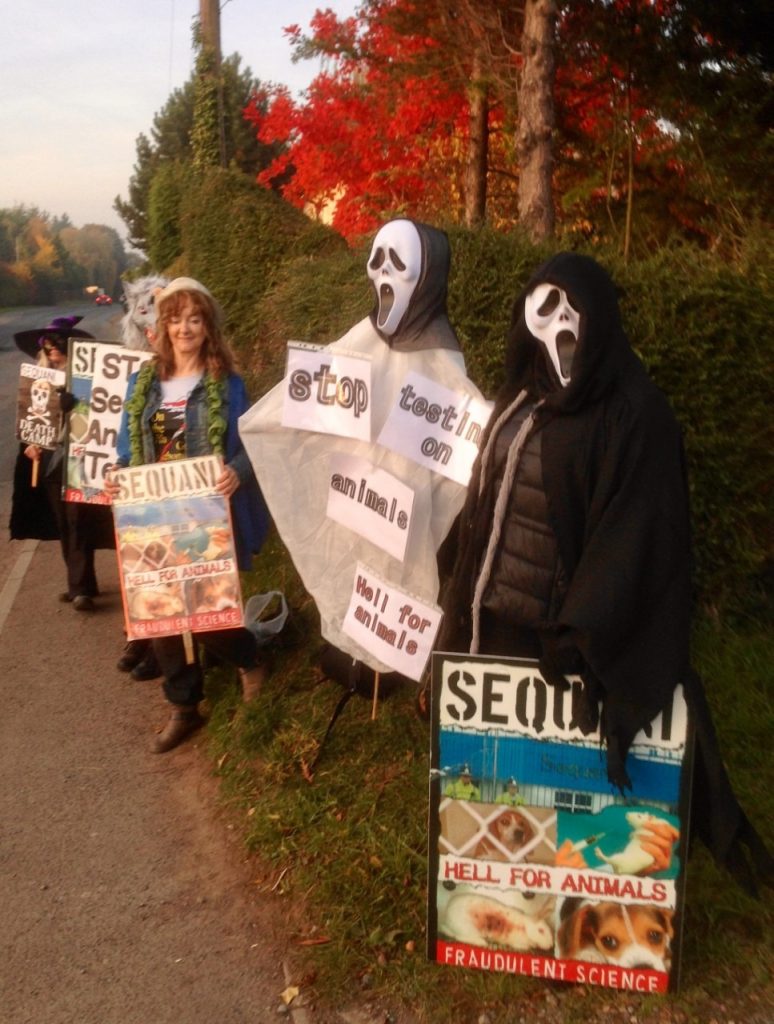
World Day at 40: 2006. Sequani is a contract testing laboratory near Ledbury in Herefordshire. It had been known by different names and was the target of various campaigns over the years.
By the time Stop Sequani Animal Torture was formed in 2005, however, the state, in the guise of New Labour, was effectively waging war on anti-vivisectionists, whom it dubbed “domestic extremists”, and had passed draconian laws against them.
In May 2006 Operation Tornado saw a series of dawn raids which led to the arrest of 12 activists over a 48 hour period. Their trial was to last 18 weeks – the longest in the animal rights movement’s history – and from the start the state used any dirty trick it could to get convictions.
No direct action had been used against Sequani yet the act of organising demonstrations was portrayed as somehow illegal and the prosecution claimed Sean Kirtley was the group’s leader. He received 4 1/2 years in prison but was released on appeal after 16 months.
The others were acquitted, except one who accepted a plea bargain, and the outcome was a vindication for the right to protest. Defendant Wendy Clark said: “It nearly killed me but I was innocent, so I stood my ground.”
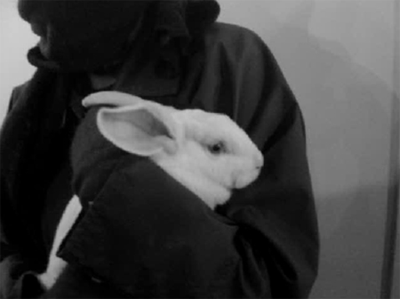
World Day at 40: 2008. On 6 January the Animal Liberation Front raided Highgate Farm in Lincolnshire, “a rabbit breeder who provides animals to suffer and die in the miserable vivisection industry”, rescuing 129 animals
An ALF communique said: “A ventilation fan was forcibly removed to evade the alarm systems on the doors. Inside rabbits were lined in barren cages breathing in the stench of shit and urea, waiting to be tortured to death in animal testing labs. But tonight, the activists had a more compassionate fate for them.”
A quad bike, lawnmower, van and a sports car were paintstripped and glued, causing damage estimated at £100,000. After the raid the farm installed a £60,000 security system to deter potential intruders.
In January 2010 Lewis Pogson was sentenced to three years for eight offences in relation to the action. It is, to date, the last time a UK laboratory animal breeder has been raided by the ALF.
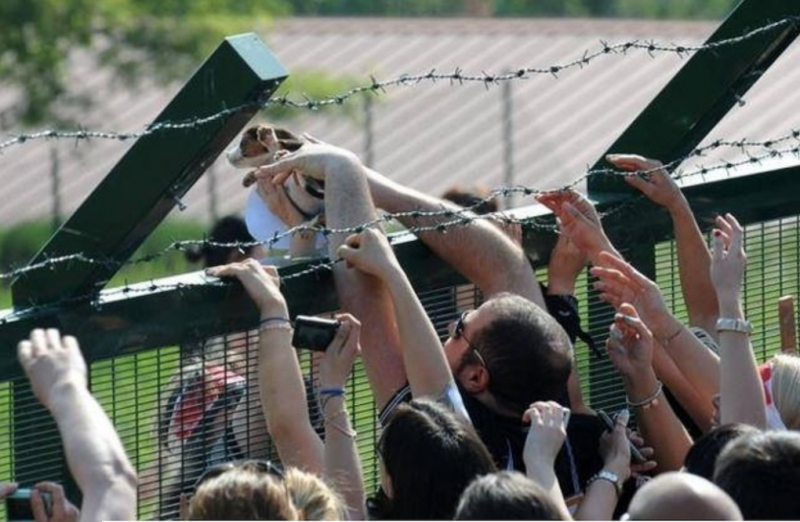
World Day at 40: 2012. Green Hill Farm, a commercial breeding facility in Brescia, Italy which supplied laboratories with 250 dogs a month, was besieged by activists who stormed the compound and passed 30 puppies over the barbed wire. Police looked on helpless.
Three months later Green Hill was raided by police who found the carcasses of 100 dogs in a freezer deemed to be “surplus” and therefore euthanised. In 2015 two managers and the company vet were convicted of unlawful killing and sentenced to up to 18 months.
The Brescian Public Prosecutor gave La Lega Anti-Vivisezione legal custody of the dogs and between July and September 2012 all remaining 2,639 beagles were found loving homes. Footage of the raid: https://tinyurl.com/y623w4hh
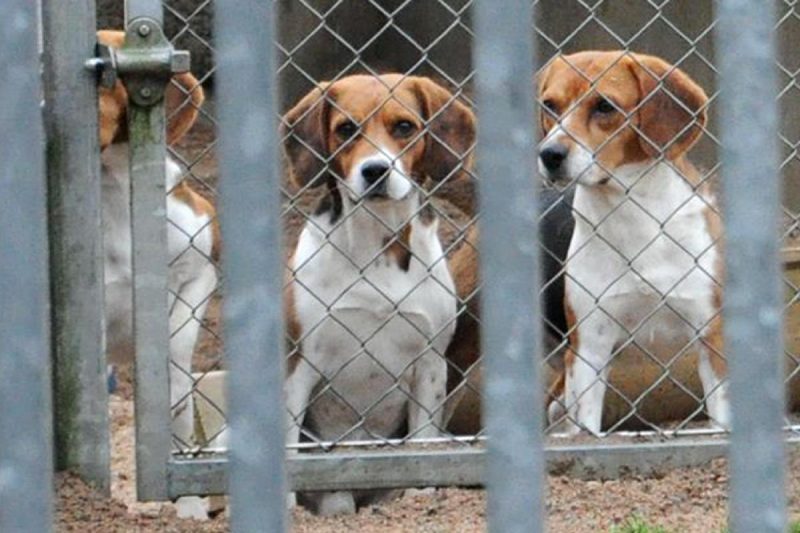
World Day at 40: 2013. Pharmaceutical giant AstraZeneca caused outrage when, having closed its kennels in Sweden, it flew 300 beagles to its laboratory in Alderley Park, Cheshire, for vivisection, rather than rehome them.
The company claimed dogs bred in captivity made unsuitable companions, despite allowing its employees to adopt 80 of them. A Swedish campaign called Let the Astra Dogs Live held a march with dogs wearing anti-AstraZeneca slogans around their necks.
Groups like PETA and the National Anti-Vivisection Society took up the campaign and a petition calling for the beagles to be saved received 12,000 signatures, while 20 organisations wrote to AstraZeneca asking them to give the dogs to good homes.
An activist interviewed in the Guardian said direct action would be used against airlines including: “Checking bags or suitcases on to flights and then not getting on, meaning all luggage would have to be taken off to remove items not connected to someone on board.”
Actions like this never happened, though, as animal rights was in a slump following years of repression. But over 100 people and 25 dogs protested at the entrance to Alderley Park demanding the beagle’s release. This was organised by a new group called Cease Animal Research Experiments.
Vicky Fraser of CARE said: “We are not being militant about this, we believe these surplus dogs should be offered the chance to be rehomed. We’ve got a waiting list of 900 people who have said they would like them.”
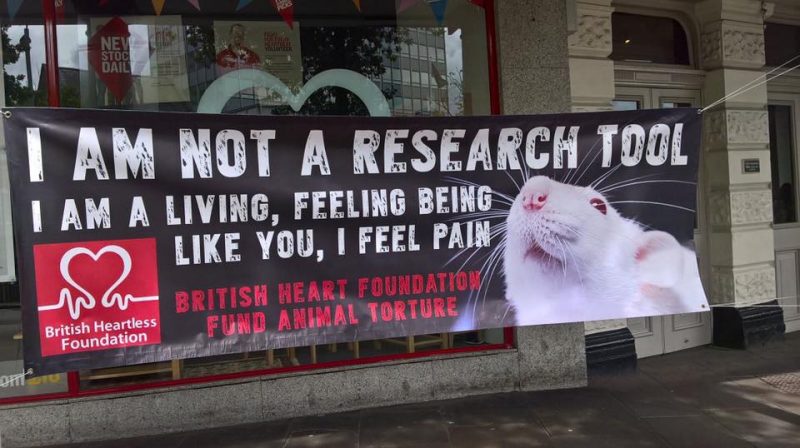
World Day at 40: 2014. British Heartless Foundation is a campaign targeting a major charity funding animal research. Its website says:
“Behind the pleasant imagery that we associate with the British Heart Foundation, smiling doctors, thoughtful patients, colourful shop fronts and fun runners pounding the streets, lies a dark secret.”
The campaign uses striking leaflets, placards and banners to tell customers about the “cruel fates that await an animal unfortunate enough to be part of a BHF ‘research project’ – they could be bred solely to have their hearts ripped out, be poisoned, or have a heart attack artificially induced”.
It has also highlighted Svetlana Reilly, a vivisector who “makes a career out of killing goats at Oxford University”. In one experiment alone 48 goats died.
BHF shops up and down the country have been picketed and nationwide days of action saw dozens of protests at the same time.

World Day at 40: 2015. The group No New Animal Lab was formed to stop the University of Washington (UoW) and its contractor, Skanska, from building a new animal research lab costing $124m.
In April 2015 500 people converged on the campus of UoW. This was the largest grassroots US animal rights protest in over a decade and out of it NNAL was born with a mission “to rebuild the animal liberation movement around a campaign to stop the construction of an underground animal research lab.”
Actions followed like Storm Skanska: Swarm New York, as the company’s HQ and many executives’ homes were in Manhattan, and Storm Skanska: Fracture Their Finances, in which investors were targeted. The group listed targets on its website, including an interactive map of Skanska locations
It added: “Diversity of tactics – that is the key. If you want to act, you do not need to wait. Just follow the campaign strategy and think creatively about what compliments all of the other activity and organizing. The campaign is an umbrella for tactical diversity and creative action.”
The blog Red Black Green praised NNAL as “the most positive development AR has seen for years…bold, decisive, confrontational and clever” with a “nuanced political and social analysis…which sits squarely within anarchist and anti-capitalist narratives of the radical left.”
Sadly it didn’t last. Demos and other actions against UoW and Skanska were reported on the Facebook page until autumn 2016 but then something happened. The website was taken down, an AR conference was cancelled and Twitter no longer updated. Facebook posts continued and one in September 2018 said the lab was built. It has proved difficult to find out more but there appears to have been an injunction.
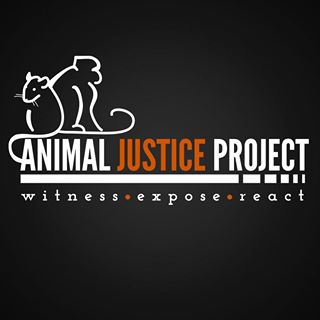
World Day at 40: 2015. Animal Justice Project was launched in March as “an international, non-profit organisation dedicated to the ending of animal experimentation and other forms of speciesism”.
2015 wasn’t an auspicious time to launch an anti-vivisection group. Months earlier SHAC had folded after 15 years of trying to close down Huntingdon Life Sciences and its coordinator Debbie Vincent had received a six year sentence for conspiracy to blackmail.
Pursuing confrontational campaigns seemed out of the question so AJP took a different approach. It went back to basics to provide evidence and expose vivisection for what it really is: cruel, wasteful and unreliable.
This was needed because the older, national societies had either ceased to exist (the BUAV, Uncaged), become moribund (NAVS) or like Animal Aid switched most of their resources from fighting vivisection to promoting veganism. This left a gap that AJP has filled.
Not that it doesn’t have campaigns, there are many and one of the main targets is universities. By making Freedom of Information requests for Campus Without Cruelty, AJP ascertained that about half of all experiments in the UK occurred in higher education.
Their latest campaign, Missing, has uncovered experiments on rabbits that universities would rather us believe weren’t happening.
Radical groups of the past who closed down lab animal breeders didn’t emerge out of nothing; they were part of a wider movement. AJP’s role in probing the hidden recesses of vivisection is crucial. It’s up to us what we do with the information.
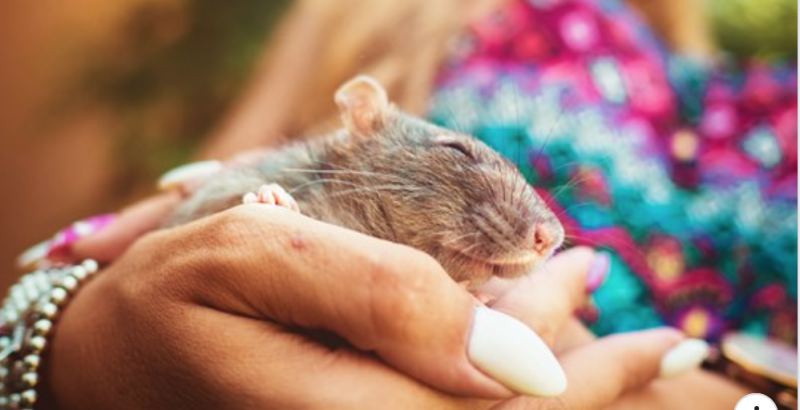
World Day at 40: 2017. Pictures of rats and mice tasting freedom for the first time. Under Italian law ex-lab animals can be released to individuals or charities if they are healthy and “saveable”. When Milan-based group La Collina dei Conigl found itself receiving rats and mice, volunteer photographer Rachele Totaro knew she had to act.
“The surprise when these little critters feel the sun on their fur for the first time, their curiosity for a brand new world to discover, how deeply they enjoy their first moments of freedom, led and protected by volunteers, who are always by their side on the long path to recovery.
Shy ones, little warriors, curious explorers, cuddle-lovers: everyone acted in a different way when taken outdoors, and they showed once again they are not mere numbers, as they are considered in labs, but individuals with peculiar attitudes and personalities”. https://tinyurl.com/y4ds4dte
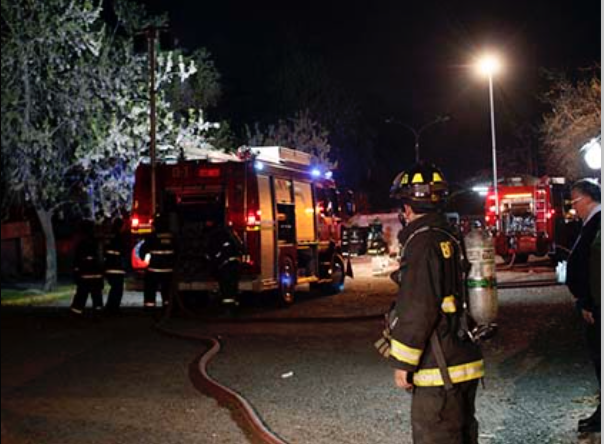
World Day at 40: 2018. In a communique issued on frentedeliberacionanimal.net a group called Incendiary Plague claimed an “incendiary attack” on the Metropolitan University of Educational Science’ animal facility in Chile.
It said: “This action was aimed at destroying and making uninhabitable a building that is used to torture, abuse and experiment on animals.” Animals including rats and frogs had been rescued on several occasions but “despite these acts of sabotage, the enclosures have been filled with animals, time and again.”
Incendiary Plague adds:”We are individuals who are external to protests at the university” and says the action was undertaken “taking care to safeguard the safety of the people who inhabit the university campus and avoid physically hurting anyone”
It ends with a warning: “Tomorrow, surely other laboratories will be victims of our fire! The spirit for animal liberation is unbreakable!”
Leave a Reply